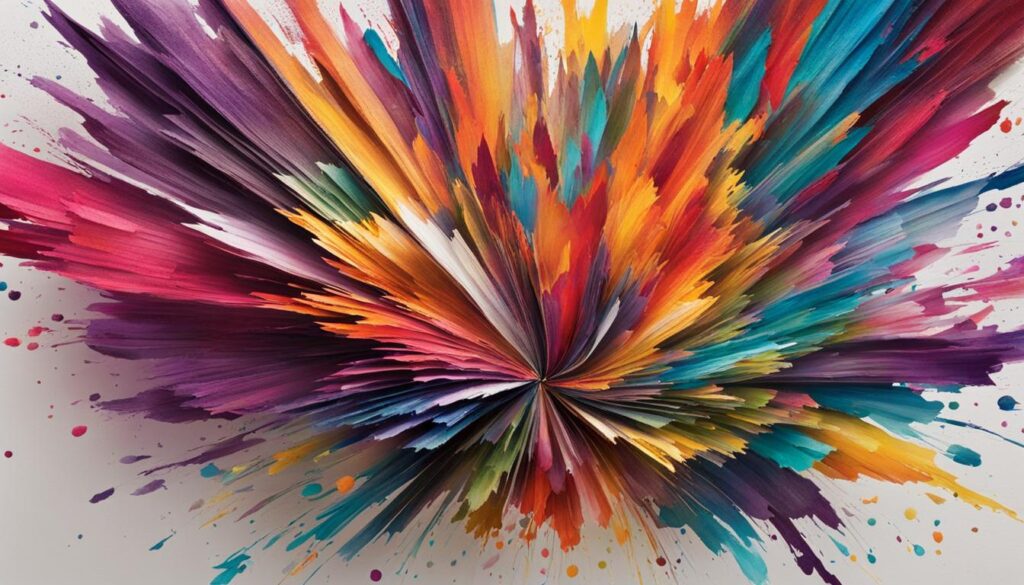We may earn money or products from the companies mentioned in this post.
Are you looking for a new way to express yourself creatively? Look no further than art journaling! Art journaling is a unique form of self-expression that combines elements of visual art and journaling to create a one-of-a-kind artistic experience.
Whether you’re a seasoned artist or a beginner, art journaling offers a wonderful opportunity to unleash your creativity and explore new art skills. Not to mention, it can also be a therapeutic outlet for self-expression, promoting mindfulness and reflection.
Key Takeaways:
- Art journaling combines visual art and journaling for a unique creative experience.
- Art journaling can help unleash your creativity and develop new art skills.
- Art journaling can be a therapeutic outlet for self-expression and mindfulness.
- Art journaling is a great way to explore different artistic techniques.
- Getting started with art journaling is easy with the right tools and guidance.
What is Art Journaling?
Art journaling is a form of creative journaling that combines elements of mixed media art and visual journaling. It is a unique form of self-expression that allows individuals to explore their innermost thoughts and feelings while creating a visual record of their experiences.
Creative journaling is the practice of writing down one’s thoughts, feelings, and experiences. Mixed media art involves using a combination of materials such as paint, paper, and other objects to create a piece of art. Visual journaling involves creating a visual record of one’s experiences through art.
Art journaling combines all three of these practices to create a form of self-expression that is both visually stunning and deeply personal. It allows individuals to explore their creativity in a way that is free from judgment and criticism.
What Makes Art Journaling Unique?
What makes art journaling unique is that it is a form of expression that is entirely personal. Artistic techniques and materials can be combined in any way that feels natural to the artist, creating an outlet that is both enjoyable and fulfilling.
Unlike other forms of art, art journaling is not about creating a finished product to be displayed to others. It is about the artist’s personal journey and the process of creating something that is uniquely theirs.
“Art journaling is not about creating a finished product to be displayed to others. It is about the artist’s personal journey and the process of creating something that is uniquely theirs.”
The Role of Mixed Media Art and Visual Journaling in Art Journaling
Mixed media art is an essential part of art journaling because it allows individuals to combine different materials and techniques to create something unique. It offers a way to experiment with different art supplies and techniques, creating a distinct style that is personal to the artist.
Visual journaling is another important component of art journaling because it allows individuals to create a visual record of their experiences and emotions. By combining art and writing, visual journaling creates a powerful form of self-expression that allows individuals to explore their innermost thoughts and feelings.
The Therapeutic Benefits of Art Journaling
Art journaling is not only a creative outlet for self-expression but also a therapeutic activity that can promote mindfulness and improve mental health. Many individuals use art journaling as a form of art therapy to alleviate stress and anxiety, process emotions, and explore their inner selves.
Through art journaling, you can express difficult emotions that may be hard to articulate in words. The act of creating art can bring a sense of calm and relaxation, allowing you to focus on the present moment and reduce stress levels.
Moreover, art journaling can be a tool for self-reflection and personal growth. By looking back at your journal pages, you can gain insights into your thought patterns, struggles, and triumphs. This can help you better understand yourself and your emotions, leading to increased self-awareness and self-acceptance.
Art journaling can also help you develop a greater sense of resilience and coping skills. As you experiment with different art techniques and navigate creative challenges, you can build confidence in your abilities and develop problem-solving skills that can be applied to other areas of life.
Exploring Art Techniques in Your Journal
When it comes to art journaling, the possibilities are endless. It’s a space for creative exploration, and you can use a variety of art techniques to express yourself. Here are some techniques to consider:
| Technique | Description |
|---|---|
| Drawing | Use pencils, pens, or markers to sketch or illustrate your ideas and emotions. |
| Painting | Use watercolors, acrylics, or oils to add color and texture to your pages. |
| Collaging | Use magazine clippings, photographs, or other materials to create mixed media collages. |
| Lettering | Use different fonts and styles to add text and quotes to your pages. |
| Stamping | Use rubber stamps to create repeating patterns or add texture to your pages. |
When exploring these techniques, don’t be afraid to experiment and try new things. Mix and match different techniques to create unique and interesting pages. Remember, the artistic process is about exploration and self-expression.
Getting Started with Art Journaling
Art journaling is a wonderful way to unleash your creativity and explore new self-expression techniques. Whether you’re a seasoned artist or a beginner, art journaling offers a therapeutic and fulfilling outlet for creative exploration. Here are some tips to help you get started:
Choose the Right Materials
When it comes to art journaling, the materials you use can make all the difference. Choose high-quality materials that will help you achieve the effects you want. Some essential materials for art journaling include:
| Material | Recommended Brands |
|---|---|
| Journal | Strathmore, Moleskine, Dylusions |
| Drawing Materials | Prismacolor Colored Pencils, Tombow Dual Brush Pens, Micron Pens |
| Painting Materials | Golden Fluid Acrylics, Liquitex Heavy Body Acrylics, Winsor & Newton Watercolor Pans |
| Adhesives | Liquitex Matte Medium, Aleene’s Tacky Glue, Zots Adhesive Dots |
Set Up Your Journaling Space
Your journaling space should be a comfortable and inspiring place where you can focus on your creative process. Create a dedicated space for your materials and set up good lighting to ensure that you can see your work clearly. Play some music or light a candle to create a relaxing atmosphere.
Overcoming Creative Blocks
It’s common to experience creative blocks when starting a new art journaling project. If you feel stuck, try some of these techniques to get unstuck:
- Take a break and come back to your journal with fresh eyes.
- Experiment with a new art technique or material.
- Work in a different part of your journal or start a new page altogether.
Remember, there are no rules when it comes to art journaling. Embrace your creativity and have fun with it!
Conclusion
Art journaling is a creative and therapeutic way to unleash your creativity, develop your art skills, and discover new self-expression techniques. No matter your skill level, art journaling provides a space for exploring your artistic process and promoting mindfulness.
If you’re new to art journaling, getting started can be intimidating. However, with the right tips and guidance, anyone can begin their art journaling journey. Take the time to choose the right materials, set up your journaling space, and overcome creative blocks.
Remember, art journaling is a personal journey, and there’s no right or wrong way to approach it. Embrace your unique creativity and use your journal as a space for exploring and expressing yourself. Start your art journaling journey today and unleash your creativity!
FAQ
What is art journaling?
Art journaling is a creative practice that combines elements of journaling, mixed media art, and visual expression. It involves using various art techniques, such as drawing, painting, and collaging, to create a personal journal that reflects thoughts, emotions, and experiences.
What are the benefits of art journaling?
Art journaling offers numerous benefits, including promoting self-expression, enhancing art skills, and providing a therapeutic outlet. It allows for creative exploration, personal reflection, and the development of a unique visual language.
Can anyone do art journaling, or do I need to be an artist?
Absolutely! You don’t need to be an artist to enjoy art journaling. It is a practice open to everyone, regardless of skill level. Art journaling is more about the process and self-expression than creating perfect artworks.
What materials do I need to start art journaling?
The materials you need for art journaling can vary depending on your preferences. Some common supplies include a journal or sketchbook, various art mediums (such as pens, pencils, paints, and markers), collage materials, and adhesive. Experimenting with different materials can add excitement and variety to your art journaling.
How do I overcome creative blocks in art journaling?
Creative blocks are common in any artistic practice. To overcome them, try experimenting with new techniques, exploring different themes or prompts, seeking inspiration from other artists and sources, and allowing yourself to make “mistakes” or take risks. Remember, art journaling is a personal journey, and there are no right or wrong ways to create.
Can art journaling be therapeutic?
Yes, art journaling can be a form of therapy. It provides a safe space for self-expression, helps to process emotions, and promotes mindfulness. Engaging in art journaling can reduce stress, improve mood, and enhance overall well-being.
How often should I art journal?
There are no rules regarding the frequency of art journaling. You can choose to create in your journal whenever you feel inspired or need a creative outlet. Some people may choose to art journal daily, while others may do it weekly or even sporadically. The important thing is to find a rhythm that works for you.
Affiliate Disclosure: This post may contain affiliate links. If you purchase through our link, we may receive a small commission, but at no additional cost to you. For more information, please see our Disclosure statement.



